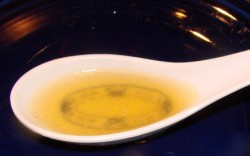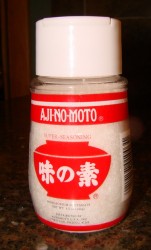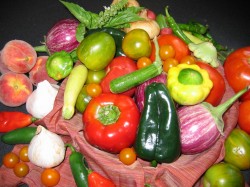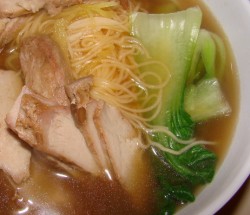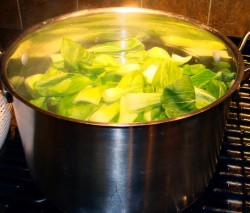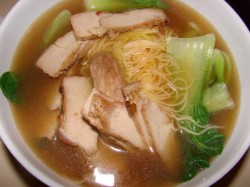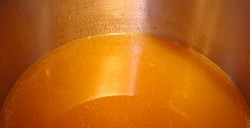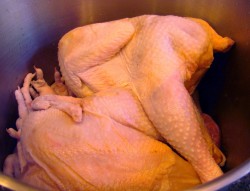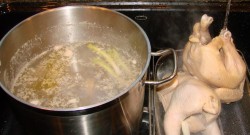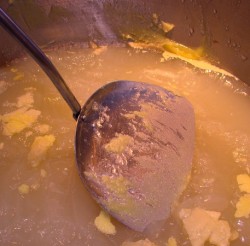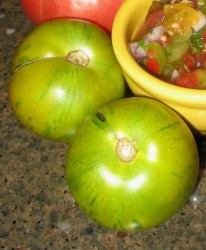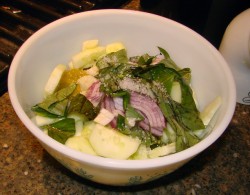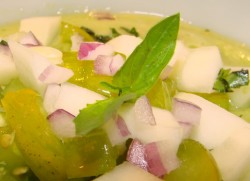The Not-So-Secret Secret Ingredient To Roast Pork Noodle Soup
Zak and I were sitting with Kat, all of us with a bowl of roast pork noodle soup in front of us (well, Kat had noodles with minced up bok choy, finely minced roast pork and a bare dribble of soup in her bowl) and we were eating happily.
Zak looked up thoughtfully from his bowl and said tentatively, “You know, this is awesome–but there is something not perfect about the broth. It is missing something.”
Now, he wasn’t telling me anything I didn’t already know. The broth was excellent, very flavorful, meaty and rich, with great body and aroma. It was a dark golden color from the soy sauce and Shao Hsing wine and the drizzle of toasted sesame oil gave it just the perfect tinge of nutty smokiness.
But still, there was something missing.
It wasn’t sugar–there was just enough in it to enhance the pork and bok choy flavors without making it taste like “candy soup,” which has a definitely unappetizing sound to it. It wasn’t lack of white pepper, nor was it that the stock was too weak–the main flavor was meat.
Zak and I talked about it while we each offered Kat spoonsful of broth from our own bowls to slurp. He said, quite clearly as he took another sip, “It has something to do with the meat flavor–it is almost right, but not quite.”
I finally stood up and sighed. “I bet I know exactly what it is,” I stated, as I strode purposefully to the kitchen, opening the spice cabinet. I plucked out a jar I have had for ever, but which I have never opened.
I carried it back to Zak and cracked it open. Over my bowl of broth, now swept clean of noodles, pork and greens, I sprinkled a few grains of sparkling crystalline white powder.
“What’s that?” Zak asked.
“MSG,” I said. I handed him the jar, and said, “I kind of wondered when I was cooking this if I shouldn’t add some, but it goes against my nature to do it. I thought about using Chinese black mushrooms or kelp to get enough glutamates in the broth, but they both have their own flavors which come along for the ride, which would clash with this dish.”
He sprinkled a few grains into his bowl, stirred it and took a sip. The umami flavor which had been missing–that meatiness, that savory component–it had arrived.
His eyes lit up. “It is almost like a whole new broth. You are right. It’s perfect.”
I tasted mine. He was right. The broth was taken to another level: it was meaty and savory and wonderful, with all of the natural flavors enhanced perfectly. That was the not-so-secret secret ingredient to make my soup taste just like the ones from our favorite noodle shops. A little tiny sprinkle of MSG. It is amazing how little was needed to add that last bit of oomph.ZZ
So, what do I suggest you do if you want to recreate this recipe?
Well, if you are opposed to MSG as an ingredient, or are sensitive to its effects, I suggest you just do without. In truth, the soup tasted plenty wonderful without it, such that Zak kept repeating as he ate his first bowl of it, “I love you, I love you. Oh, I love you.”
So, the soup was fine, really.
But, if you want it to taste just like you remember from some noodle shop somewhere, wait until you have poured the hot soup over the noodles, pork and greens in a bowl. Then, sprinkle a few grains of MSG, known in Japanese as Aji-no-moto, over the broth and give it a stir with a chopstick. I am of the opinion that it is easier for you to season it by the serving than by the potful–it would be too easy to end up using too much MSG if you try to season several quarts of soup broth at a time.
Remember, you want to use as little MSG as possible if you use it at all. If you overuse it, instead of enhancing the flavor of your food, it will flatten it out and make it one dimensional. And you might end up unintentionally giving your guests a headache.
And if you don’t want to use it–that is fine, too. Your soup will still be good without it.
For thoughts on MSG and health, check out my earlier posts:Let’s Talk About MSG and More on MSG and Glutamates
Eat Local Month 2007: Eating Locally as a Spiritual Practice
In celebrating of September as Eat Local Month, I offer an essay I wrote for a local newsletter for shamanic healing practitioners on a subject often overlooked by those who write about eating locally: the spiritual aspects of local food.
Generally, rather than talking about reducing the carbon imprint of my food, or talking about the ecological and economic advantage to eating locally (although I believe in all of these reasons) my way of tempting others to eat local foods is by taking about how delicious they are, and what a sensual delight it is to eat the seasonal produce from your own corner of the world.
However, there is another strong reason I have animating my decision to eat as locally as possible as often as possible: it is part of my own daily spiritual practice to do so.
I am offering this essay to provoke discussion, and to initiate a sharing of ideas and feelings on the intersection between food and spirituality. As a deeply spiritual person whose personal philosophy closely follows the precepts of Zen Buddhism, and whose beliefs mirror many of the tenets of some branches of the Hindu faith, I cannot extricate the physical realm from spiritual reality. For me, they are inextricably intertwined, like honeysuckle vines growing interwoven with climbing rose canes.
In my world, everything I do is a spiritual act. When I grow food, or shop for it at the farmer’s market or local grocer, I am observing a holy rite. When I go into my temple, the kitchen, and cook, I am performing a ritual. When I serve the food I have cooked to my family, friends and clients, I am sharing a sacrament.
This is just my experience. I do not judge those who do not or cannot eat locally as lacking in spirituality. That is not my point. It is not for me to judge how, when, why or why not any other human may (or may not–I don’t look down on atheists, either) connect with Spirit. (Unless, of course, an individual’s method of connecting to spirit involves causing terror, pain and death to others–in that case, I reserve the right to stand up and say, “Uh, no dude, that is not right.”)
My point in posting this essay, which some may perceive as a bit “out there” is because I want to see if there are others who share my experiences surrounding food, whether the food is local or not. I want to see a discussion about where food and spirituality intersect among us, how, when and why.
So, if you feel so inclined, post a comment and let me know what you think.
Without further ado: here is the essay in question.
Food, Spirit and a Sense of Place
I grew up eating locally.
As the granddaughter of a farming family who raised cattle, chickens, hogs, and vegetables, I learned early in life what truly fresh foods tasted like. I also learned what labor went into the growing and production of food as I followed my grandmother down the garden rows, planting seeds, hoeing weeds and transplanting seedlings every spring. In the heat of summer through the crisp days of autumn, we harvested: canning, preserving and freezing in preparation for the fallow season of winter. In the early winter, we slaughtered our animals, with care to do so in the most gentle and ethical way possible, then butchered them and stored the resulting meat in the freezer to feed our whole extended family in the coming year.
In light of this rather unusual upbringing, it should come as no surprise that I have since endeavored to eat as close to the source of my food as possible. Not only do I dislike the concept of shipping vegetables hundreds or thousands of miles from the soil in which it was grown, I mistrust the rampant use of chemical fertilizer and pesticides that are necessary to run monocropped factory farms. I also abhor the inhumane practices of confined animal feeding operations where most of the meat animals in our country are raised. These unsustainable farming practices may produce a great deal of food cheaply, but they come at an astronomical environmental health and ethical cost.
Pesticides target the crop pests they are meant to destroy, but they also kill beneficial pollinating insects. Runoff from chemical fertilizer causes algae bloom in adjacent rivers and streams, deoxygenating the water and killing the fish and other life within it. Pesticides, herbicides and some fertilizers cause mutations among populations of amphibians, or kill them off outright, while pesticide residues, as they travel up the food chain by ingestion from lower life forms to higher, cause untold numbers of unforeseen environmental hazards. (A good example of this would be the weakening of the eggshells of predatory birds by DDT in the 1960’s and 70’s which led to many raptor species going onto the endangered species list.) And of course, these poisons, many of which are nerve toxins, pose health dangers to farmworkers, their families and residents who live near farms, which include declining fertility rates, rising rates of cancers and other toxic effects.
CAFOs pose heath disasters for animals and humans alike. Manure dust from enclosed chicken houses can give farmers and chickens alike serious respiratory illnesses, deadly strains of e. coli have developed in response to the unnatural conditions under which cattle are raised, and resistant bacteria have arisen and are threatening human health due to the overuse and abuse of antibiotics in CAFOs. Runoff from manure lagoons destroy groundwater and streams, pouring bacteria into the environment, and the stink of so many animals living in their own feces reduces air quality in a large radius around CAFOs, reducing property values for homeowners, as well as the quality of life for those who live nearby.
The way in which CAFO animals are treated in many slaughterhouses is often monumentally cruel and painful; and the workers in such facilities are often treated little better. Production lines move so quickly that not only are animals who should have been stunned are being cut into while they are alive, workers often experience accidental wounds from the razor-sharp knives they are forced to wield at an inhumane and unsafe pace. In addition, in the name of speed, care is not taken to keep the e coli-contaminated intestines of animals away from meat, resulting in widespread contamination.
Ethically and morally speaking, I find it egregiously shameful that we feel it is necessary to raise food in such unhealthy ways without question. Why is it considered right and proper to torture animals and inflict unsafe production practices upon human workers and farm neighbors in order to make a surplus of cheap food? Why are farmers, who risk their health and sometimes their very lives to feed us paid so stingily? Why do we lose so much farmland every year to new housing developments and strip malls while small farmers go bankrupt?
In addition to these already acknowledged ecological, health and ethical costs of the current petrochemical-based agriculture, there is also an often overlooked spiritual cost to the animals, plants, planet and ourselves when we consume food that is raised using unethical, unsustainable methods. As a woman who has been deeply connected to the rhythms and spirit of the land since childhood, I cannot help but be aware of this seemingly unending well of pain and corruption that comes from working against nature in order to feed ourselves, instead of working with nature.
When we take from the Earth without giving back, we are destroying not only the soil, the environment, the plants and animals, we are destroying ourselves. When we act as if there are no consequences to our agricultural methods, we are fooling ourselves: taking up arable land for more shopping centers may not destroy us, but it may very well starve our children and grandchildren. City dwellers may not be harmed directly by pesticide use, but the farmer workers are–how is this right and good?
I believe very deeply that when we cause pain to humans, animals, plants and the very land itself in order to grow food, we are literally eating that pain, and it becomes a part of us, in an endless cycle of negative energy. When we eat that pain, how does it taste?
As humans, we have forgotten that we are not apart from nature; we are intimately entwined within the web of all life. And as such, we must understand that our every action and inaction affects everything we do. If we choose to eat apples shipped to us from New Zealand, instead of the ones grown in our home county, we are choosing not only to ignore our local economy and neighborhood farmers while supporting the use of massive amounts of petroleum to ship fruit half a world away, we are also spurning the spiritual and physical gifts of the Earth where we live.
Perhaps eating far from the source of food may be helping humans feel disconnected from the Earth. I believe very strongly that not only does the soil in which a plant is grown affect the flavor and nutritious components of that plant, it also has a subtle effect on the energy field of that plant, stamping it spiritually with a sense of place. When we eat food of questionable nutritious value shipped from all over the world that we buy wrapped in plastic and far from the soil in which it was grown, we may be feeding our own sense of rootlessness and not belonging to our communities.
Our physical health, as well as our spiritual health is affected by our food choices. For example, all plant foods are filled with vital vitamins, minerals, photochemical, carbohydrates, proteins, fats and bioflavenoids, all of which are necessary to sustain life. As soon as a vegetable or fruit is taken from the ground or parent plant, these energy-giving and life-sustaining elements begin to wane, fading rapidly the longer the interval between the farm to the table. When we eat far from the source of our food, we are robbing ourselves of the nutrients that plants give us.
But, if we eat what is grown and produced close to us, or even better grow some of our own food ourselves, we not only foster a spiritual sense of connection, of belonging, of being part of the natural world, we also boost our physical health by eating food more filled with nutrients. We become more aware of our place in the natural world, and it helps us take better care of ourselves, our families, our land and our planet.
As a part of my spiritual practice, I buy most of my family’s food from local farmers, and cook most of our meals, all from healthy whole foods. Here in southeastern Ohio, we are uniquely able to purchase local, ethically and sustainably produced meats, dairy products, eggs, fish, honey, wine, herbs, vegetables, fruits, mushrooms, tofu, pasta and breads. Ohioans, as are others across the United States and the world, are becoming increasingly aware of and interested in the economic, environmental and health values of truly fresh local food, and because of the state’s strong tradition of agriculture, we could stand at the forefront of this new movement.
I only hope that the spiritual value of ethically produced local foods will also become known to the people of my home state, as well as those across the country and around the world. Local food has the potential to not only sustain our bodies, our communities, our families, our neighbors and our environments, it can also sustain our spirits, and help us reconnect with the natural world.
A Noodle Shop Classic: Roast Pork Noodle Soup
In many cultures around the world, a steaming bowl of noodle soup is the next best thing to a mother’s embrace. Noodle soup can be spicy or mild, filled with vegetables, or meat, or seafood or tofu, or made of just broth and noodles–it can be simple and stark, or elaborate and dressed to the nines with garnishes. Whatever form it takes, noodle soup is nothing less than comfort in a bowl for countless people across the world.
One of my favorite versions is the Chinese noodle shop standby, roast pork noodle soup. Made with thin fresh or dried wheat and egg noodles and a chicken and pork broth simply seasoned with a bit of salt, sugar, soy sauce, and toasted sesame oil, with thin slices of char siu, Cantonese roast pork, and blanched greens of some sort, this soup is an amazing restorative. If I feel under the weather it perks me up, if I am down, it makes me smile, if I have a headache, it clears my sinuses (especially if I add chile garlic sauce or chili oil at the table!) and if I am nauseous, it settles my stomach.
It does the same for Zak who loves the soup even more than I do. Something about the sweet barbecued pork combined with the savory broth, firm, springy noodles and sweet, lightly crisp greens just sings to him, and he tells me he would eat this dish every day if he could.
If we lived nearer to a noodle shop, I reckon he would, but since I have to make it from scratch, we eat it now and again, and treasure it all the more.
In truth, once the soup stock is made and the pork is roasted, the soup is simplicity itself to put together. All you need to do is pick out a nice green to be blanched to go in the soup, and cook some noodles.
My favorite greens for this soup are choy sum and baby Shanghai bok choy. Shanghai baby bok choy are the ones that have pale jade green stems and dark green leaves, and are only about two and a half inches tall; regular baby bok choy has white stems and deep, almost pine green leaves. I think that the Shanghai variety has more flavor and is slightly sweeter.
This time around, I used baby bok choy; they were extremely fresh and are very sweet this time of year and are so easy to prepare. Just cut off the bottoms of the tiny cabbage cousins, where the leaves all come together. Rinse them well under cold water and bring a big pot of salted water to a brisk boil. Dump the bok choy in, and stir to get them covered with the water. As soon as they wilt a bit–which will take all of a few seconds, pour out the leaves and water into a colander in the sink and rinse them thoroughly with very cold water to instantly stop the cooking. The result should be leaves that are barely cooked and softened with lightly wilted stems which have darkened slightly. The stems should still have a nice tender crunch to them.
After you deal with the greens, you need to pick out your noodles. My favorite for this soup are fresh thin wonton noodles from Twin Marquis. They are available in the refrigerated sections of many Asian markets, and they are the closest to the very thin, flavorful, pliant yet springy egg noodles used in Chinese restaurants and noodle shops. I neglected to photograph the package before I tore it open to cook the noodles, but there is a photograph of these noodles as you will see them in the stores on the Twin Marquis website–just look at the noodles on the extreme right in a styrofoam tray wrapped in plastic wrap.
If you use these noodles, be very careful–when the cooking instructions say that they cook in 60 seconds, they are not kidding. Have a big pot of water boiling, then take each of the four bundles out of the package and carefully detangling the noodles with your fingers, sprinkle them over the boiling water into the pot. Work quickly, stirring between bundles, until they are all in the pot, then start timing. I take them out at fifty seconds, personally, just to be certain.
I scoop them out with a skimmer and tongs, and instead of putting them into a colander, I set them in a very large metal bowl. (This is because they are so fine, they would slither right through the holes in most colanders!) When they are all out of the water, i rush them to the sink, and rinse them in very cold water, filling the bowl up and swishing them around with my hands to make sure they are all separate and not sticky with starch. Once they are cold, I drain out the water, and toss the cold noodles with about a teaspoon of sesame oil to keep them from sticking to each other. (This entire process works with many kinds of Chinese wheat noodles and is outlined here. In addition to rinsing the starch from the outside of the noodles, soaking them briefly in cold water brings a great chewiness and resilience to the noodles without making them tough or gummy.
Once you have the soup stock flavored and boiling, and the pork sliced, the greens prepared and the noodles cooked, you are ready to put everything together. But, before you do that, you might want to add one more little fillip, one little grace note that I add to my own version of Roast Pork Noodle Soup. I cut a single peeled fresh garlic clove and a similar sized piece of peeled fresh ginger into tiny julienne–pieces as wide as a blade of grass–to be sprinkled on top of the noodles. These tiny aromatic bits cook instantly as soon as the boiling hot soup stock hits them and give just another layer of nuanced flavor. If you don’t mind the cutting, give my idea a shot and see what you think.
After this–it is all a matter of assembly. Pre-warm the bowls by running hot water into them and then pouring it out. Set them on the counter next to your soup pot. Layer a serving of noodles (the Twin Marquis twelve-ounce package of thin wonton noodles is enough to feed four adults and a baby) into the bowl, and then top with a tiny sprinkle of the slivers of garlic and ginger, if you are using them. Arrange thin slices of pork over the noodles artfully, and drape the blanched greens along the interior edges of the bowl. Drizzle a scant 1/8 teaspoon of toasted sesame oil over the noodles, and then carefully ladle the boiling stock into the bowls–using enough to cover the noodles, pork and greens fully, without completely drowning everything in a tide of soupy goodness.
That is it. The only thing left is to season your individual bowl to taste with garlic-chili sauce or chili oil, and then slurp and enjoy.
Ingredients:
2 1/2 quarts soup broth made from Chinese chicken and pork stock
salt and white pepper to taste
sugar to taste
light or thin soy sauce to taste
Shao Hsing wine (or dry sherry) to taste
12 baby Shanghai bok choy, bottoms cut off to loosen leaves
12 ounce package Twin Marquis thin wonton noodles (or 12 ounces dried or fresh thin egg noodles)
12 ounces char siu, sliced thinly
1 large clove fresh garlic, peeled and cut into very fine julienne (optional)
1 piece fresh ginger–the same size as the garlic clove, peeled, cut into fine julienne (optional)
2 teaspoons toasted sesame oil
chili garlic sauce and chili oil (served on the side)
Method:
Bring soup broth to simmer. Season to taste with the salt, white pepper, sugar, soy sauce and wine.
Bring a large pot of water to a boil, and drop in the bok choy. As soon as the leaves wilt, drain and rinse in very cold water. Drain and set aside.
Bring another large pot of water to a boil. Remove noodles from package, one bundle at a time (they are packed in four bundles), loosening the noodles as you sprinkle them over the boiling water and into the pot. Working quickly, put all four bundles into the pot, and stir with chopsticks. Cook forty-five to sixty seconds. Remove noodles from boiling water with a skimmer and tongs, and put them into a large bowl. Rinse in very cold water, soaking the noodles briefly to firm them up. Drain the noodles and after wiping a dab of sesame oil over your palms, massage it into the noodles to keep them from sticking together. (You don’t need much oil for this.)
Bring soup broth to a full boil.
Warm four bowls in hot water, then dry. (You can also warm them in the dishwasher on the heat dry cycle, or in a warming oven if they are oven safe.)
Divide up the noodles into four portions and lay them in the bottom of the bowls. Arrange equal portions of pork along the top of the noodles, and add equal portions of bok choy leaves along the edges of the bowls. Sprinkle the tops of the noodles with small amounts of garlic and ginger. Drizzle 1/2 teaspoon of sesame oil over the noodles.
Ladle boiling soup over the bowls, covering the contents. The soup must be boiling in order to warm up the rest of the ingredients.
Serve with chili garlic sauce and chili oil so each diner can add as much or little as they desire.
Making Basic Chinese Chicken and Pork Stock
Normal people have cookouts on Labor Day weekend. They gather around the grill with their buddies for a day of beer, beach volleyball, and burgers.
At least, that is what most folks did when I was growing up.
I have long since given up on pretending to be normal; everyone who knows me terms me what was politely called “different” in my hometown of Charleston West Virginia. In the UK, they have a more melodious term for it which I prefer: eccentric.
So, what do eccentrics like me do on Labor Day?
We kick back for a relaxing day of making Cantonese Roast Pork Noodle Soup.
Why bother to make a noodle shop classic on a holiday?
Because it may well be a noodle shop classic, but as there are no classic noodle shops here in Athens, Ohio, eccentrics like myself take up the challenge to make it at home.
And really, it isn’t such a bother as all that. It just requires that you make a couple of elements of the recipe in advance: roast pork, and proper Chinese stock, in order to make the soup taste right.
I have already taught you how to make roast pork, also known as char siu, so this post is going to cover the basics of making Chinese style chicken and pork stock in your very own kitchen.
Really traditional Chinese chicken and pork stock is essential to making excellent Chinese noodle soups. With hot and sour soup, which has so many other flavoring elements, a plain chicken broth or stock can be used, but noodle soups rely less on seasonings and more on traditional meat stocks for flavor. I have found over the years that taking the time to just go ahead and make the proper Chinese stock makes more sense in the long run, than it does to start with a substandard packaged broth.
Besides, it is easy to make lots of stock at once and then freeze the excess for use in soups and other recipes later. So long as you have freezer space, this is a good plan–and frankly, after tasting good homemade stock, lots of folks will -make- freezer space for it.
For those of you who have read my post on making classic French style chicken stock entitled, “Making Stock: The Good, The Bad, and The Ugly,” you have a good working knowledge of how to make basic stocks. If you haven’t read it, or have never made stocks before, please follow the link and read it; I explain very carefully the science behind making stocks, and all of the whytos and wherefores about working with bones and animal parts with which one may not be familiar.
The Chinese method is very similar to the French method, but it is much more usual for there to be a mixture of meats and bones in the basic stocks of the Chinese kitchen. Usually the mixture includes parts of chicken and of pig; chicken and pork are the basic meats of most of China, so they are what is used on a daily basis in the kitchen. Chinese Muslims will exchange the pork for lamb or beef, while strictly vegetarian Buddhists will eschew meat stocks all together and will make vegetable, mushroom and seaweed based broths.
The amounts of pork bones and meat to chicken bones and meat are roughly 1:2; the types of pork and chicken bones and bits you use are up to you. I like to use pork neck bones and country ribs with thick slabs of meat on them. I also learned the trick of using a slice of ham with a bit of bone in it from reading Florence Lin’s excellent books on Chinese cookery and I wholeheartedly agree with her; the slight smoky flavor the ham imparts to the stock is perfect. The chicken I use tends to be whole chickens (giblets removed–organ meats make stocks somewhat bitter) and chicken feet. I like the flavor and body that chicken feet give to the stock, though backs and necks are good, too.
Whatever you use, be sure and rinse the meats and bones thoroughly with cold water and trim away excess fat, as well as any obvious bloody spots.
Blanching the Bones and Meat
One other major difference in the Chinese method of stock making and the French method is that the bones and meat are always blanched before they are made into stock. This means that you put all of your bones and meat into the pot, cover them with cold water and bring them to a slow simmer, then allow them to boil for about ten minutes. At this time, a great amount of blood, fat, and other impurities (connective tissues, proteins and the like) will be pulled out of the bones and flesh and will result in a large amount of scum rising to the surface of the pot. Skim the scum as you do in French stock making, and then, after fifteen minutes, turn the heat off of the pot, remove it from the stove and pull out the bones and meat. Rinse all of them under cold water, scrubbing them with your hands well to remove the flecks and bits of ick that have stuck to them.
I know for a fact you won’t want to do this, and since the French chefs don’t do it, I can sense folks thinking, “Why should I?”
There is a very good reason for it, and it is this: simply skimming the scum from the top of the stock as it simmers never gets all the floating particulate matter out of the stock. The French get past this by either refrigerating the stock over night and skimming off the rest of the particulate matter, which floats to the top and adheres to the fat layer. Since the French remove most of the fat from the stock and tend not to use it for anything else (this is generally true, but not in every case), this works well. However, Chinese cooks and chefs leave some of the fat intact, and when they skim the rest, they tend to save it for use later. (There is another French method for clarifying stock that is an utter pain in the rear end to do: it involves using ground veal, egg whites and egg shells to make a floating “raft” which draws the impurities to the top of the stock, where it all floats together and becomes trapped in a big glom on the top. Then, you remove the raft, and voila–clear stock. What a pain!)
So, rather than make rafts or waste fat, the Chinese get rid of the nasties before they make their stock, and the result is a much clearer product with what turns out to be less work in the end. It just doesn’t seem that way when you are doing it the first time or two.
After you have rinsed all of your bones, bits and meat, drain out the rest of the water. You will notice a big layer of scummy, icky mess all over the inside of your stock pot. Scrub it clean! You don’t want that in your stock!
Then, after you have rinsed the bones, bits and meat, -and- scrubbed your pot clean, put everything back, along with your vegetables: I use scallions and fresh ginger, which is traditional, along with a few carrots, which is not traditional, but which gives a nice subtle sweetness and color to the stock. Put the pot on the fire, bring it to a simmer, and let it cook at a bare shimmering simmer for about six hours. Eight is better. Nine is best.
Skim the tiny bits of scum that float to the top of the pot and get rid of them. You won’t have to do this very much–most of that stuff was blanched away in the first step.
After six to nine hours of simmering, it is time to pull the bones, bits and meat out, and then pour the stock through several layers of cheesecloth. I always save the meat bits for later uses–even if it is just as a treat for the kitties–and then I wash the stockpot again, then put the stock back into it and cool it off before refrigerating it overnight.
Skimming the Fat
After the stock has been chilled overnight, you will find that the fat has congealed on the top in a velvety pale yellow layer. You will also find that the stock has most likely congealed into a mass of pale translucent gelatin. That is good! That means you made a great stock filled with body and vitality that any Chinese chef would be proud of. The pale color is fine; the color of Chinese soup stocks comes from the soy sauce that is added later; for basic stocks, only a small amount of soy is added and only after it has cooked all the way. The solidified cold stock occurs because of the natural gelatin that is present in bones and connective tissue, and has been extracted by the cooking process. Gelatin gives stock a special body and feel that is delicious on the tongue, and gives a velvety feel to soups and sauces made with it.
Skim most of the fat off the top of the stock; when I am dealing with a solid gelatin layer beneath the fat, I find that it is easiest to simply “slice” the fat off with a wok spatula.Take almost all of the fat off and don’t worry if you get some bits of the gelatin with it. Save the fat and stock chunks you skim off; for one thing, you may want to add a tiny bit more fat to your stock after you have reheated and seasoned it to give it further richness. For another thing, you can stick it in the freezer, and if you are using commercial chicken broth for a Chinese recipe and want to give it a bit more flavor and oomph, you can add a bit of the stock and fat to it.
Finishing the Stock
Once most of the fat is off the surface of the stock, reheat it on medium heat, stirring it as the gelatin and fat melt into a pale liquid. At this point, season it with some thin or light soy sauce and some Shao Hsing wine, and bring it to a simmer What you will find is that you have a lovely, fragrant amber stock filled with the essence of both chicken and pork, which is barely salty and has the depth of Shao Hsing Wine. Golden droplets of fat bead up on the top in ephemeral bubbles of iridescence, and this stock is now ready to be used as a basis for soups, braised dishes, sauces or any other use in the Chinese kitchen.
Making Soup from the Stock
Making a basic, neutral-flavored soup stock from the plain chicken and pork stock is simple: After bringing it to a second simmer and seasoning it, allow it to reduce by about 1/4. This will strengthen the flavors of the stock a bit and give it a better, more luxurious mouthfeel. At this point, season it to taste with light soy sauce, salt and a tiny bit of sugar. This is now a basic soup stock that is ready to be simmered with whatever flavorings are needed for a particular soup, or to be used as is.
Chinese Style Pork and Chicken Stock
Ingredients:
4 pounds of pork bones and meat, including a slice of ham with a bit of ham bone
8 pounds of chicken bones and meat, including either necks and backs or feet
water as needed
6-8 scallions, trimmed and rinsed, white and light green parts only
3 medium carrots, peeled and cut into thirds
3″ chunk fresh ginger, peeled and cut into three parts
about 1/4 cup light or thin soy sauce
1/4 cup Shao Hsing wine
Method:
Trim excess fat and any obvious bloody bits from the bones and meat. Rinse all in cold water, and put into pot large enough to hold them all. Add cold water to cover. Set on stove, turn heat to high and bring to a simmer, then a boil. Boil for ten to fifteen minutes, allowing scum and impurities to gather as a dirty foam on the top of the water.
Remove from heat, and with tongs, pull out bones and meat and put them into a strainer. Pour out all water and discard. Rinse the meat and bones thoroughly with cold water, rubbing as necessary to remove the collected scum from their surface. Scrub out pot. Return meat and bones to pot along with scallions, carrots and ginger. Add cold water to cover and put on stove. Turn heat to medium and bring to a simmer. Turn down until a very bare simmer is maintained, with the water shimmering and tiny bubbles collecting around the solids and the sides of the pot, then bursting slowly.
Allow to cook like this for at least six hours. Nine is better. While it is cooking, check to make certain it is not boiling, and skim any foamy scum that collects at the top–there will not be much, but there will be some. You only need to do this a couple or three times.Other than that, you can ignore the stock as it cooks.
When it is finished cooking, remove the bones and meat with tongs or skimmer. Remove meat and save it if you want. Discard bones (Compost heaps are good places to bury the bones, but not the meat.) Put about four to six layers or cheesecloth into a colander and put this contraption over another pot (you may need to use several pots to collect all of the stock from the stockpot) and strain the stock in it. Scrub out the pot, and return the stock to it. Cool it down as quickly as you can–I like to set the pot into the sink along with a bunch of ice and water and stir the pot until it comes down to forty degrees. Then, I cover the pot and stick it in the fridge overnight.
In the morning or sometime the next day or evening, skim most of the fat off the top of the pot. Add the soy sauce and wine, and put the pot back on the stove, turn the heat to medium low and stirring, bring to a simmer. If you want, add a bit more fat to the stock–the surface of the liquid stock should be dotted with swirls of golden bubbles or beads of liquid fat. Too much makes it greasy, but too little makes it flavorless.
If you want, follow the instructions above to make the stock into a basic soup stock, or package and freeze it as is for use in soups, sauces and braised dishes later.
How Green Was My Gazpacho
Heirloom tomatoes offer an amazing array of colors, shapes and flavors to tempt the palate and the imagination of the cook.
It is great fun to use them in classic recipes to bring a new twist to old favorites. My best beloved heirloom tomatoes are the lovely little Green Zebras. They are about the size of a plum, with chartreuse to yellow skin striped with deep green and kiwi-colored flesh. Their flavor is a good balance of sweet and tart, with a tangy finish that goes beautifully in salsas or with goat cheese in salads. I also like them as a topping on open-faced toasted cheese sandwiches along with basil and pine nuts, but in August, the last thing I want to do is fire up my broiler in order to make lunch.
Gazpacho is a staple recipe in my summer kitchen; this Spanish cold soup is perfect for the sweltering days of August when onions, garlic, tomatoes and cucumbers are in wild abundance, and appetites are on the wane because of the hellish heat. Thanks to modern technology, gazpacho a quick way to use up the bounty from the garden and farmer’s market without lighting a burner on the stove or breaking into a sweat.
There seem to be two ways to eat your gazpacho: blended or chunky. Folks who favor the blended sort of gazpacho like their chilled soup to be smooth, with all the vegetables pureed into a thick, red silken bowl of comfort. This method of preparing the soup forces all of the ingredients marry together into a harmonious whole that is unbroken by individual flavors.
The folks who like their gazpacho chunky, however, want to see the different colors, and experience the different flavors in quick bursts under their teeth. The truth is that even chunky gazpacho has some pureed component to make the dish somewhat sloshy; otherwise one would be eating a salad, not a soup. But aficionados of the chunky gazpacho tend to put as little puree in their soups as is physically possible while still making a soup.
As for me, I fall in the middle. I like the smooth cool puree that goes so soothingly down the throat, but also like a little bit of texture to set my teeth into. So, I make my gazpacho by pureeing 2/3 of my ingredients, and then taking the final third, and dicing or mincing them finely, to be mixed into the frothy puree. An immersion blender makes quick work of this process; all I have to do is roughly chop my tomatoes–I leave the skins on because I like having the fiber in my diet, and because the tiny flecks of yellow and darker green look pretty in the puree–cucumbers, onions, garlic and chile peppers (I was fresh out of sweet peppers–bad me), and then let the blender do the rest. After I add extra virgin olive oil, a dash of white wine vinegar, and a pinch of salt to the bowl, it only takes a few passes with the “magic wand” of the stick blender to take care of this stage of the process.
Within a few seconds, the vegetables are reduced to a frothy, thick liquid the color of a very fresh Haas avocado, with tiny flecks of deep green, yellow and violet from the tomato skins and red onion. The olive oil gives the mixture of delicious velvety quality that is hard to replicate any other way; bread-thickened gazpacho is good, but not as silky as one with a good amount of olive oil in it. (I actually thought of using some avocado to take the place of some of the olive oil, but I wasn’t certain how that would change the taste of the gazpacho. I may try it next week if I can get more Green Zebras at the market this weekend.)
Then, I just carefully dice the other third of the tomatoes, cucumbers and onions finely, and add some minced lemon basil, which is an innovation for the dish this year.It adds a sparkling basil flavor enhanced by a definite citrus tang. I mix them together, leaving a handful of the chopped bits to garnish the top of the soup, and voila! A beautiful cold soup is born: a healthy, light meal or snack to help nourish a wilting body on a sunbaked day.
The green color, punctuated by bits of yellow from the tomato skin, the white of cucumber, and the violet of red onion, is to me more cooling than the traditional red. The colors, in fact, brought to mind the delicate colors of jade: celedon green flecked with emerald and peridot shades, cloud-white and delicate orchid.
The Green Zebras also lent their tang to the soup; I didn’t use as much vinegar in it as I have in past years, in large part because of the acidic tang of the tomatoes, and also because I wanted the lemon basil to take a starring role in the flavor profile of the soup.
It was definitely an experiment which paid off, and I am proud to say that with the exception of the olive oil and vinegar, all of the ingredients for this dish were grown within ten miles of my home: some (the chile and lemon balm) as close as my deck.
When you read the recipe, you will note that some of my measurements are approximate. That is because much of gazpacho making is the art of working “to taste.” Some people like it more sour, others like it sweeter. Some like more of the herbal flavor, while others favor the peppers and cucumbers. Others want nothing to step in front of the voluptuous kiss of the tomatoes.
Just look at this recipe as a guideline and create your own gazpacho of a different color.
Jade Zebra Gazpacho
Ingredients:
6 Green Zebra tomatoes–four very ripe and two just ripe
1 fresh garlic clove, peeled and sliced
1 medium size cucumber, peeled and cut into thirds
1 small red onion, peeled and cut into thirds
1 small green chile (or one small green sweet pepper) cut into thirds
1/8 -1/4 cup extra virgin olive oil
1/2 teaspoon salt or to taste
1/2 tablespoon white wine or sherry vinegar (or to taste)
3 tablespoons roughly chopped fresh lemon basil
tiny lemon basil leaves to garnish
Method:
Roughly cut up the four very ripe tomatoes without peeling them and put them into a deep bowl. Add the garlic and two thirds of the cucumber and onion, both roughly chopped. Roughly chop two thirds of the chile or sweet pepper, and add it to the bowl, along with the olive oil, salt, white wine vinegar and two tablespoons of the basil.
Using an immersion blender, puree the ingredients until a thick, frothy liquid forms.
Carefully seed the remaining third of the cucumber, and carefully cut the remaining tomatoes, cucumber, and onion into a very fine dice. Mince the remaining bit of chile and the basil leaves, and then mix all of these vegetables together. Leave a few tablespoons of these chopped vegetables aside as garnish, and stir the rest of them into the soup. Cover and chill the soup and garnishes.
Before serving, sprinkle garnishes, including whole lemon basil leaves, over the top of the soup, and serve in small cups or bowls as an exquisite appetizer or spoon it into larger bowls for a light lunch.
Powered by WordPress. Graphics by Zak Kramer.
Design update by Daniel Trout.
Entries and comments feeds.

